There’s no shortage of pencil art scenery ideas to spice up a sketchbook—think misty mountain mornings that seem straight from a dream, lakes so calm they reflect every cloud, and winding forest paths just begging for a friendly fox to stroll by. Artists can try gentle river bends, sketch sleepy village streets, or tackle the drama of ocean cliffs. Even gardens on foggy mornings, cozy woodland clearings, and sun-dappled fields offer endless sketchy adventures. Exploring the next set will spark even wilder inspiration!
Key Takeaways
- Sketch serene lakeside reflections, focusing on symmetry and gentle shading to create realistic mirrored landscapes.
- Draw misty mountain mornings by layering graphite to capture fog and enhance atmospheric depth.
- Illustrate dreamy forest pathways, using perspective and shading to add depth and whimsy to wooded scenes.
- Create picturesque coastal cliffs, utilizing shadow, jagged lines, and crashing waves for dramatic, dynamic scenery.
- Render sunsets over rolling hills, blending soft gradients and silhouettes for vibrant, visually striking sky compositions.
Misty Mountain Mornings
Although waking up early isn’t everyone’s idea of fun, there’s something magical about misty mountain mornings that makes it totally worth it. The soft, hazy light wraps everything in a dreamy, gentle glow, turning even a simple pencil sketch into high quality art.
Artists love how the mist lets shadows and highlights play hide-and-seek, giving their drawings awesome depth. Using different line thickness and clever shading, anyone can capture the mysterious fog swirling around peaks. Layering graphite creates that spooky, faraway feeling that mist brings.
Taking a compact sketchbook out to the mountains and sketching on the spot helps artists notice subtle blues, grays, and greens in real life. It’s peaceful, inspiring, and honestly, even better than cartoons before breakfast.
Serene Lakeside Reflections
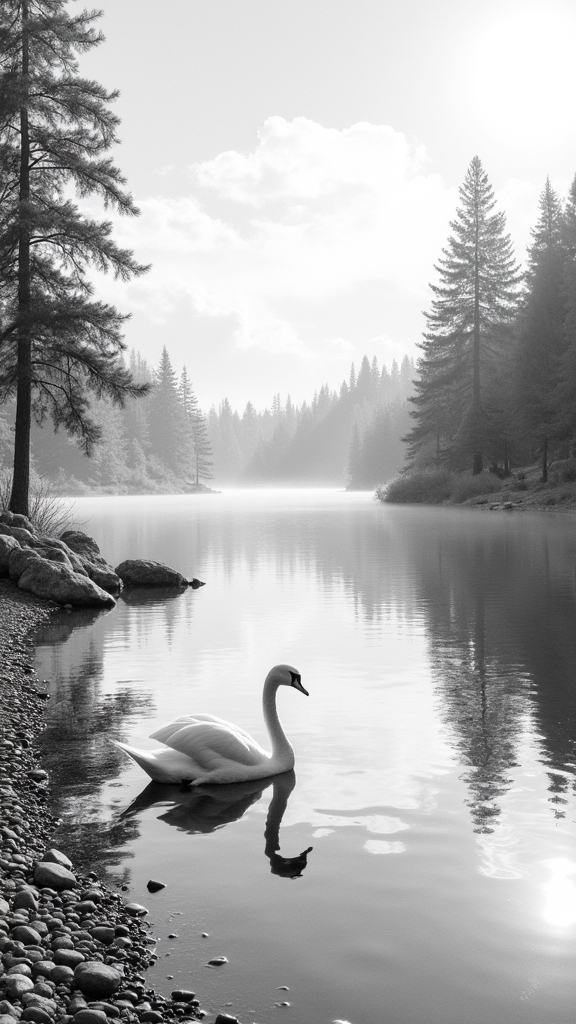
Nothing beats the calm feeling of drawing a quiet lake, especially when the water is so still it acts like nature’s very own mirror.
Sketching reflections of trees and sky on that glassy surface can feel almost like a magic trick—get it right, and suddenly your drawing has double the scenery!
With a few clever pencil strokes and some playful light and shadow, you can make your own lakeside scene look so real, you might just want to jump in and skip a rock.
Capturing Still Water
Mirror-like lakes can turn any drawing into a peaceful masterpiece, but capturing that perfect, glassy reflection isn’t just about copying what’s above the water. In creating art focused on still water, it’s all about symmetry—watch how trees and mountains line up with their watery twins.
Experimenting with hatching or cross-hatching brings texture to the calm surface, giving the scene a heart-thumping sense of quiet. Pay close attention to light—those sparkly highlights and deep shadows make reflections feel real.
And don’t forget the little details, like lily pads or tall reeds at the shoreline, to draw viewers in. Choosing a soft sunrise or glowing sunset adds drama, making even the simplest lake scene burst with personality. Talk about instant zen!
Reflective Surface Techniques
Every bit of magic in a lakeside pencil drawing comes down to mastering those reflective surfaces, where the world seems to turn upside down.
First things first: sketch that horizon line! If it’s wobbly, even the fish would notice. Using reflective surface techniques means working lightly with pencils—soft strokes for gentle water ripples, blending with a stump or even a tissue, makes everything look glassy and calm.
Here’s a twist—add mountains or trees in the background, then mirror their shapes into the water, but with smoother details. Play with pencil pressure to turn up the drama in dark reflections and lift the mood with lighter highlights.
Don’t ignore negative space; it helps the reflection “pop” off the page. Layering mistakes? No worries—erase and adjust as you go.
Tree and Sky Mirror
Chasing those perfect reflections gets even more fun when trees and the sky step in as the stars of the scene.
Picture a calm lake, with a bunch of quirky trees lined up on the shore, their shapes and squiggly textures looking way cooler in pencil than in real life. For the sky, gradients are your best friend—soft pastels for sunrise, deep blues for twilight, totally up to your mood!
Now, the fun part: the water. This is where your inner artist can let loose, using lighter shading and wiggly lines to capture those mirror-like reflections and gentle ripples. If you have a reference image, it’ll help!
Try adding a swooping bird or a lone boat. Suddenly—bam!—tranquil lakeside magic.
Dreamy Forest Pathways

If you’ve ever felt like taking a walk in a storybook, dreamy forest pathways are the perfect way to let your imagination roam wild on paper.
These winding trails can lead anywhere—maybe into a misty adventure or a peaceful escape from homework. Creating a series of these scenes in your sketchbook lets you explore all kinds of dreamy forest pathways, each with its own twist.
To make your art pop, consider these tips:
- Try experimenting with perspectives like paths that disappear into the distance, or branches arching overhead to add depth.
- Use shading to imitate sunlight filtering through leaves, making soft contrasts and magic shadows.
- Don’t forget whimsical details—maybe some sneaky squirrels or scattered wildflowers lurking along the path.
Let your creativity wander!
Gentle River Bends
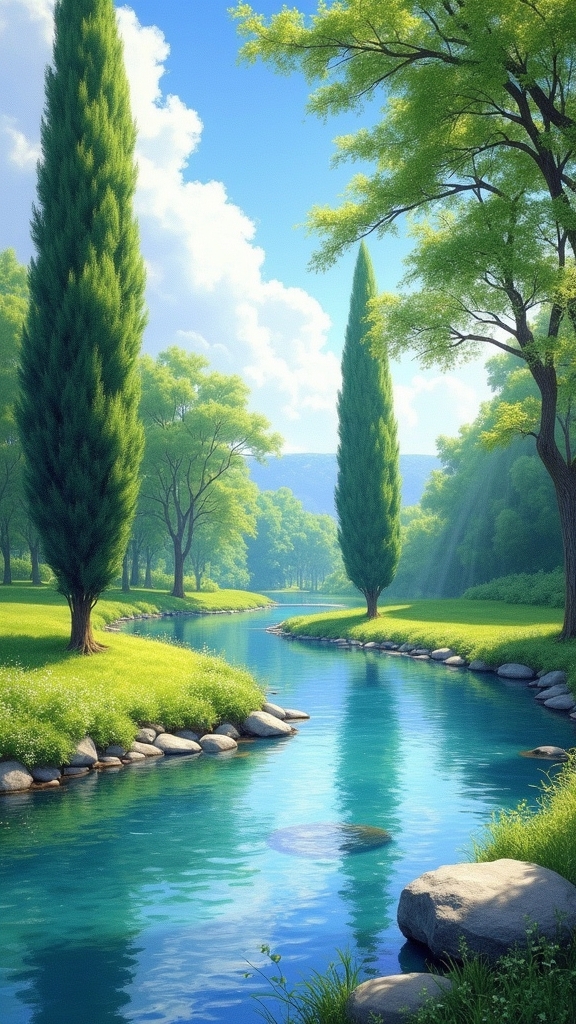
While winding rivers might seem tricky to draw at first, there’s something incredibly calming about sketching gentle river bends. When someone says, “I’m creating a river scene,” they’re usually in for a peaceful ride. The soft curves of the water can be captured with flowing lines, and if you observe carefully, you’ll notice how light dances on its surface. Imagine adding rocks, grasses, and leafy banks. That makes the scene pop! For extra fun, experiment with different angles—maybe peeking from above, or right at the bank’s edge.
| Observation Tip | Drawing Technique |
|---|---|
| Watch reflections on water | Try gentle cross-hatching |
| Add nearby grasses and rocks | Use stippling for texture |
| Notice shadow patterns | Vary pencil pressure |
| Include birds or water lilies | Frame with leafy branches |
It’s almost like nature’s own masterpiece, ready for your sketchbook!
Tranquil Garden Scenes
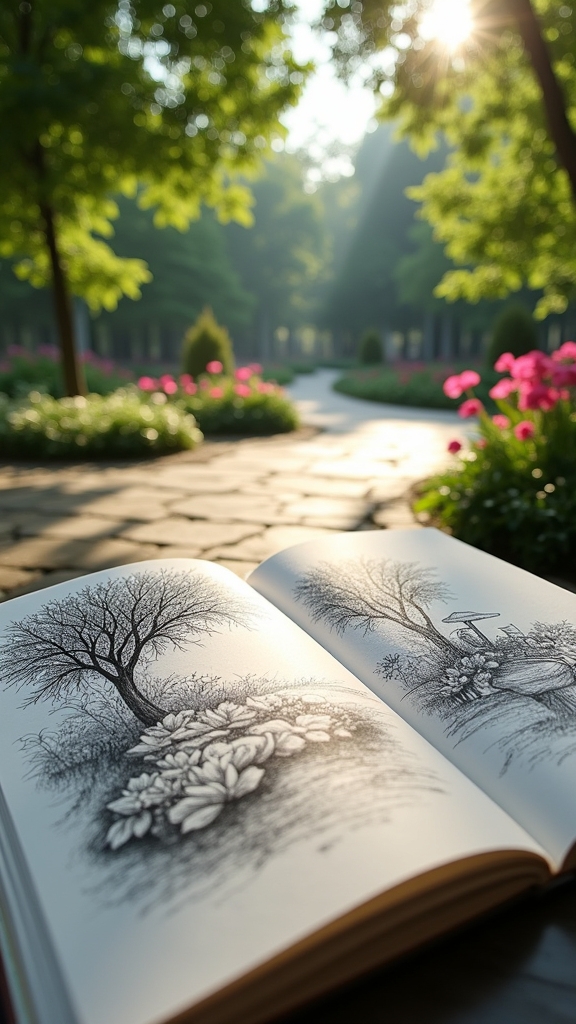
There’s something magical about catching the sparkle of morning dew on leaves, especially when you try to show it with just a pencil.
Exploring quiet corners of a garden, maybe behind a bush or near a hidden bench, can reveal secret little scenes that feel like your own tiny adventure.
Sunlight slipping through the leaves adds an extra challenge, making the whole sketch pop if you get those light and shadow bits just right—like nature showing off and daring you to keep up!
Capturing Morning Dew
Just before the world fully wakes up, a garden can feel like it’s shimmering with secrets—all thanks to morning dew glistening on every leaf and blade of grass.
If you’ve ever thought, “I’m creating a masterpiece,” now’s the time to prove it! To really capture that magical dew, try mixing soft pencils and charcoal for delicate textures that show off light and shadow.
Different leaves—ferns, flowers, grasses—hold dew in their own special ways, so experiment with a bunch.
Here’s how you can get those details just right:
- Use thumbnails to plan where your dew-drenched plants will go.
- Get up early, find a good spot, and sketch the dew before it fades.
- Practice gentle shading for the glistening, reflective effect.
Quiet Corners Explored
How does someone even find the calmest spot in a busy garden? Sometimes, it’s all about wandering off-path, sneaking behind hedges, or settling under a low-hanging branch—quiet corners explored where the rest of the world fizzles out.
Tranquil garden scenes come alive in pencil art, with artists capturing blooming flowers, twisty vines, and maybe a sneaky squirrel or two. Different ideas pop up, like sketching the tough bark of a tree versus the fluffy texture of a rose petal. Those little textures and unique observations of nature make every drawing feel special.
Changing perspectives—peeking up through thick leaves, or looking down at tangled roots—can add surprising drama. A sketchbook full of serene imagery shows just how much creativity lives in these peaceful nooks.
Sunlight Through Leaves
A magical thing happens when sunlight streams through garden leaves—it turns an ordinary patch of grass into a living painting.
Sunlight through leaves isn’t just pretty; it’s also super fun to sketch! Notice how the dappled light dances on the ground, making cool shapes and shadows. When drawing tranquil garden scenes, I’m using different pencil grades to create dramatic contrast between the sun’s bright highlights and the deep shade beneath branches.
Try laying down some hatching or cross-hatching to show the texture of the leaves and that soft, glowing light. To really make your drawing pop, follow these steps:
- Add foreground details, like flowers or winding garden paths.
- Use overlapping shadows for realism.
- Capture gentle movement—think swaying leaves and fluttering petals.
Sunsets Over Rolling Hills
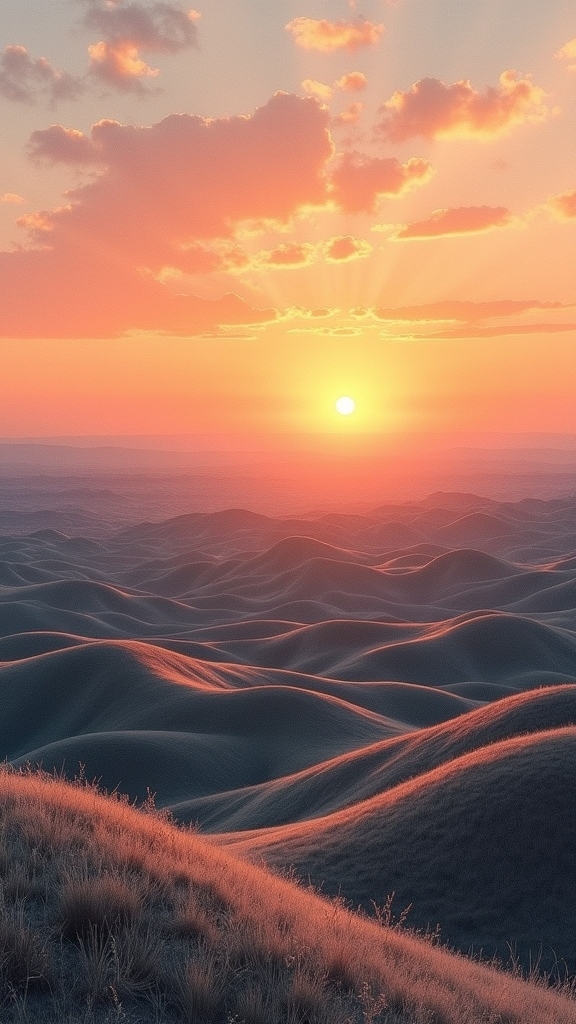
There’s something almost magical about drawing sunsets over rolling hills—those sweeping views where the sky melts from bright oranges and pinks into deep purples and blues are basically nature’s way of showing off.
Seriously, when it comes to sunsets over rolling hills, it’s like the land is getting tucked in under a golden blanket. Artists should focus on nailing the color gradients in the sky by layering and blending pencil shades, making sure those colors spill smoothly from one to the next.
Soft pencils work best for sketching out the gentle hill shapes, with a little shadow play to add some drama. Toss in a silhouetted tree or jagged distant mountains to frame everything, and maybe add a few wispy clouds catching those last sunbeams—instant wow factor.
Calm Ocean Horizons
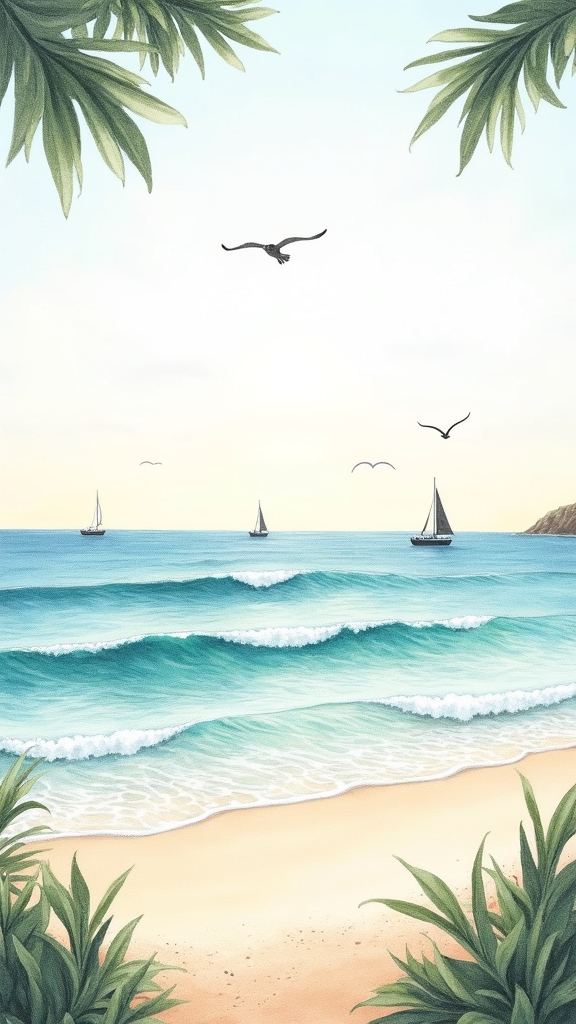
Calm ocean horizons can feel like pure magic, especially when you figure out how to show those gentle waves rolling in and the sky softly blending from one color to another.
With just a pencil and some shading tricks, artists can make the water look smooth and peaceful while the sky quietly glows above it all.
Messing with the way you blend and sketch lets you show off the quiet movement of the waves and create a sky that looks like it might shimmer right off the page—no sunscreen required.
Capturing Gentle Wave Motion
Sometimes, it feels like oceans are just showing off with how effortlessly they move—gentle waves rolling in, barely making a sound, but somehow stealing all the attention.
If an artist wants to capture that soft wave motion, they should try using some specialized pencil tricks. For starters, a loose, flowing wrist can help sketch out those smooth lines mimicking the ocean’s gentle push and pull. Observing how sunlight bounces off the water, subtle shading can bring the waves to life. Artists can sprinkle in deeper tones where the water looks thick, and save the lighter touch for foamy crests.
Here’s a simple guide:
- Try using soft, sweeping lines for wave motion.
- Vary pencil pressures for texture.
- Add delicate shading for light reflections.
Blending Gradual Sky Tones
Once those gentle waves are sorted out, it’s time to look up—literally. The real magic of any calm ocean horizon is in blending gradual sky tones. Grab a handful of colored pencils—think soft blues, dreamy pinks, and gentle purples. Start lightly, layer these colors one by one until you see a smooth gradient. No rushing! Want your sky as flawless as a fresh phone screen? Use a blending tool or even your fingertip to soften those pencil lines. Adding a bit of white pencil or gel pen brings in those sunlit highlights. And, if you want some extra flair, shade in tiny clouds or distant birds. Take a peek at this table to organize your approach:
| Step | What to Do |
|---|---|
| Choose soft colors | Blues, pinks, purples |
| Light layering | Slow, gentle strokes |
| Blend and smooth | Smudge lines softly |
| Add details | Highlights, clouds |
Quiet Village Streets
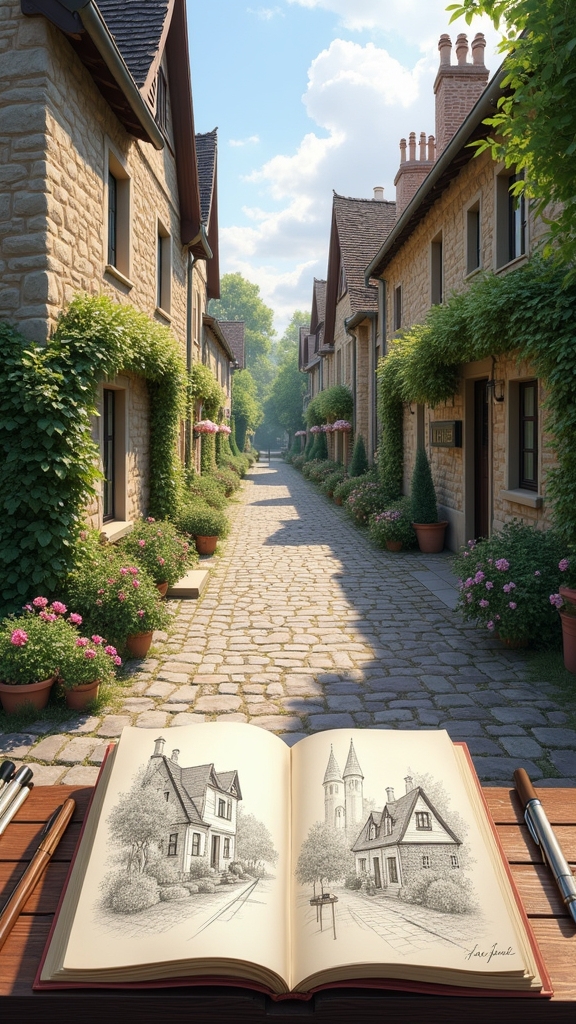
A walk down quiet village streets can feel like stepping right into a storybook—only this time, the pencil is in your hand instead of a hero’s sword.
These peaceful scenes hold secrets in every corner: cobblestone paths twist past old cottages and colorful flower boxes that almost beg to be doodled.
Cobblestone paths meander by old cottages and bursts of blooms—each turn whispers inspiration, inviting your pencil to capture their hidden charms.
Don’t just focus on what’s pretty, though—try to capture how light dances across buildings or sneaks between leafy trees. Even the quirkiest street lamp or the tangled vines on a fence give a drawing life and personality.
To take your village streets from flat to fantastic, try:
- Shifting your viewpoint—maybe a bird’s eye angle or from a shadowy corner.
- Experimenting with day or evening lighting.
- Highlighting unique details like window boxes or winding stones.
Peaceful Park Benches
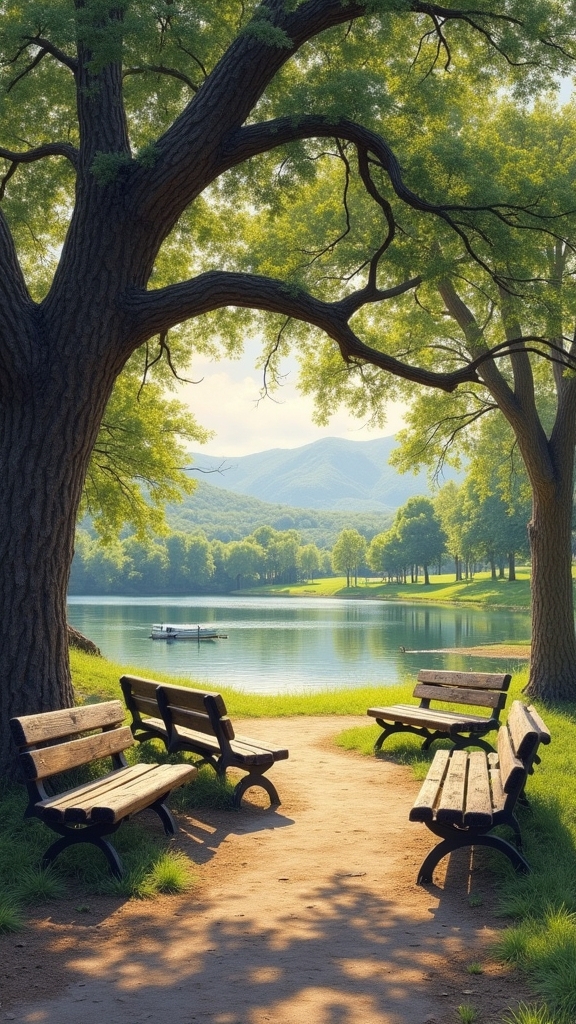
Though it might look like just a spot for someone’s snack break, a peaceful park bench in a drawing can tell a whole story all on its own.
Imagine a bench resting quietly under the cool shade of tall trees, or maybe it’s tucked beside blooming flowers or even by a still pond—with the right art supplies, you can make it feel super calm.
Play around with close-ups to show off cool wood carvings or twisted metal arms, or zoom out to capture a squirrel dashing by or someone lost in a book.
Shadows and light make everything pop—soft sunlight in the morning feels totally different than the rosy glow of sunset.
Peaceful park benches offer endless ways to experiment, sketch, and surprise yourself.
Blossoming Spring Meadows

Even if someone doesn’t think of themselves as the “outdoorsy type,” it’s pretty much impossible not to get swept up by the wild energy of a blossoming spring meadow. Bursts of color from daisies, bluebells, and poppies practically beg for a spot in your sketchbook.
When tackling blossoming spring meadows, don’t forget your black brush for those little shadows under clumps of grass or wildflowers. The dynamic light, the tangled grasses, and even the distant hills make each drawing session an adventure.
To capture the magic, try focusing on:
- Layering textures for wild grass and mixing flowers.
- Using the black brush to create soft or bold shadows.
- Adding background elements like trees or gentle hills for depth.
Let your pencil dance!
Starlit Countryside Skies
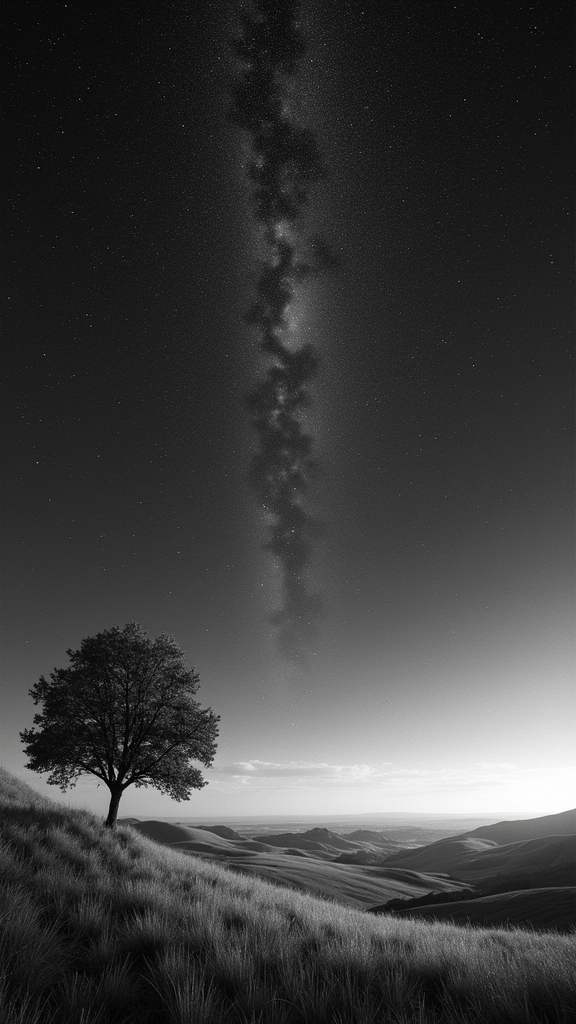
Drawing starlit countryside skies is all about creating a scene that feels calm, mysterious, and just a little bit magical—like something out of a storybook.
Artists focus on the cool, moody colors of nighttime and play around with different ways to scatter stars across the paper, almost like sprinkling sugar on a cookie.
Getting just the right mix of glowing stars and peaceful dark skies can turn a simple drawing into a stargazer’s dream!
Capturing Nighttime Atmosphere
If someone has ever spent time gazing up at a countryside sky on a clear night, they know there’s something magical about all those stars shimmering above the peaceful hills.
Capturing nighttime atmosphere in a pencil drawing starts with the horizon: sketch gentle rolling hills to set the scene. Shading comes next—smoothly shift from a deep, moody navy at the very top of the sky to a lighter shade hovering just above the earth.
Now comes the fun part: finished filling the sky’s texture, add contrast with black silhouettes of trees or cozy little farmhouses, making those bright stars pop.
Here’s a simple process to follow:
- Sketch rolling hills and the horizon for perspective.
- Gradually shade the sky for a twilight effect.
- Dot stars and add silhouettes for visual impact.
Drawing Star Patterns
While some might think sketching star patterns is as easy as dotting the page at random, there’s actually a whole universe of things to contemplate when drawing a starlit countryside sky.
The first thing to do? Look up—or check out some awesome night sky photos for reference. Real stars aren’t just sprinkled evenly. Some are super bright, others are tiny, and a few form cool constellations or the shimmery Milky Way.
Try mixing up star sizes, adding in big twinkles and little specks for depth. Use soft pencil shading to blend the sky from dark at the top to lighter near the horizon.
Don’t forget those countryside silhouettes—think windswept trees or rolling hills—to anchor all that cosmic sparkle and make your starry scene pop!
Sheltered Woodland Clearings
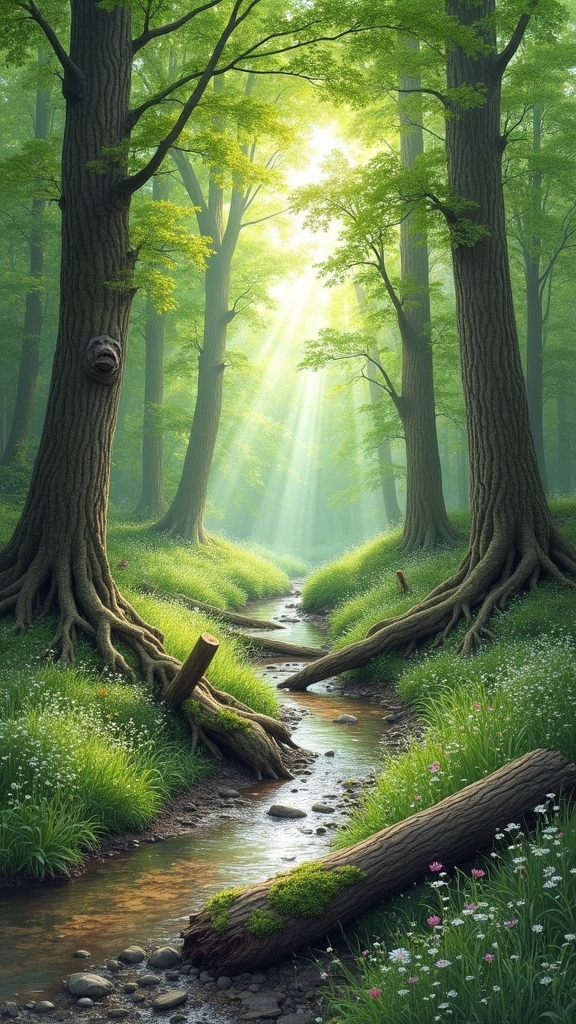
A hidden clearing in the woods can feel like stumbling into a secret world, where sunlight sneaks through the leafy ceiling and paints wild patterns onto the ground.
Sheltered woodland clearings offer all kinds of cool details, so when someone says, “I’m creating a scene,” it’s hard not to imagine those wild textures: tufted ferns, tangled wildflowers, and new sprouts everywhere.
Sometimes, grabbing new supplies can make drawing all the different types of trees and undergrowth even more exciting.
Try focusing on:
- The play of dappled light and shadow – perfect for practicing pencil shading.
- Drawing unique plants and the twisty shapes of woodland trees.
- Adding little creatures—birds, bugs, maybe even a squirrel—that say anything but boring.
With every sketch, a clearing’s secret story slowly emerges.
Picturesque Coastal Cliffs

Cliffs are nature’s skyscrapers, standing tall above the ocean with faces worn rough by wind, salt, and time. Each jagged edge and craggy ridge tells a wild story—one you can capture on the very first page of your sketchbook.
Coastal cliffs are anything but boring; they’re packed with cool textures and wild patterns from centuries of erosion. With your pencil, you can play with shadow and perspective, making those sheer drops look truly daring.
Try drawing waves crashing below or a few bold seagulls swooping overhead for extra drama—and maybe some coastal grasses clinging for dear life.
Don’t worry if you can’t visit cliffs in person; reference photos are perfect for soaking up unique rocky shapes and details.
Early Morning Fields

Every early morning field looks like it borrowed a magic filter straight from a dream. Light sweeps across dewy grass and wildflowers, making them sparkle, and the whole place feels wrapped in quiet magic.
An early morning field shimmers with dreamy light, dew-kissed grass, and a gentle magic that feels almost otherworldly.
When sketching early morning fields, artists get to capture gentle shadows, soft textures, and the peaceful mood right after sunrise.
Think about what makes these fields so cool for pencil art:
- Observe the layering—fields stretch back forever, and sketching distant trees or the horizon really amps up your sense of depth.
- Study the wild plants—their shapes and patterns make for awesome details in a drawing.
- Play with light and shadow—morning sun, fluffy clouds, and dark corners are perfect for showing off your pencil’s range.
Early morning fields are nature’s best art class!
Whispering Willow Trees

Once the sun peeks a little higher and the field’s magic gives way to full morning, willow trees sort of steal the show. Whispering willow trees are awesome for sketching because their long, drooping branches create a peaceful mood. If you’re the type who loves drawing reflections, willows are usually hanging out near water, just waiting for you to pencil in the shimmer. Their skinny leaves and bumpy bark? Perfect for trying all sorts of pencil strokes, from soft to scratchy. And don’t forget, these trees totally change with the seasons—fresh in spring, full in summer, golden in autumn, skeletal in winter. Add some ducks, a sleepy riverbank, maybe even distant hills for drama. Here are some ideas:
| Willow Tree Idea | Description |
|---|---|
| Reflection on Water | Add ripples, double the serenity |
| Autumn Golden Canopy | Warm hues, crunchy fallen leaves |
| Bare Winter Branches | Stark shapes, moody atmosphere |
Frequently Asked Questions
What to Draw 100 Ideas?
When considering what to draw, one can explore 100 ideas ranging from imaginative dream scenery and abstract concepts to detailed studies of daily life. Dream scenery offers endless creative possibilities, encouraging artists to visualize and interpret fantastical worlds.
What to Fill a Sketchbook With?
When considering what to fill a sketchbook with, artists often explore various Sketchbook Themes, including studies of local flora, urban settings, and imaginative compositions, blending observation with creativity to develop skills and showcase their evolving artistic interests.
How Do I Fill an Empty Sketchbook?
To fill an empty sketchbook, one could apply various Sketchbook Techniques, such as daily observational drawing, experimenting with mixed media, and producing quick compositional thumbnails. Utilizing references and revisiting recurring subjects encourages skill development and creative exploration.
What’s the Coolest Thing to Draw?
The Current Question explores the endless possibilities for creative expression, as the coolest thing to draw often depends on individual Drawing Inspiration. Some discover excitement in imaginative creatures, dynamic cityscapes, or merging real-life observation with fantastical elements.
Conclusion
With these 15 pencil art scenery ideas, sketchbooks are about to get a serious upgrade. Whether someone’s chasing misty mornings or scribbling wild willow trees, there’s always a new scene to explore (or accidentally smudge—oops). Every page is a fresh adventure, no passport required. So, pencils up, imaginations ready! There’s no rule saying a masterpiece can’t start with a simple line or even a doodle. Who knows? The next great sketch could be just a scribble away.


Leave a Reply